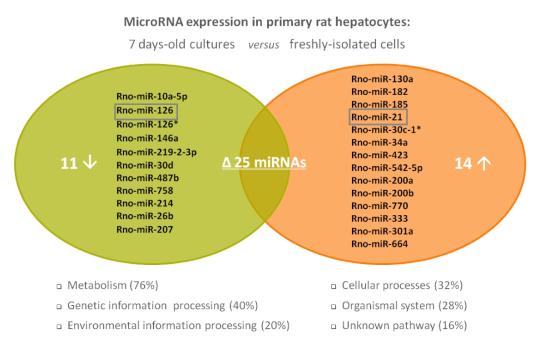microRNA (miRNA)-mediated gene silencing is a recently discovered mechanism that inhibits processing of mRNA, and hence negatively regulates gene expression. Currently, we explore the role of changes in the miRNA profile in the dedifferentiation seen in primary hepatocytes in culture.
Indeed, we recently could show that important changes in miRNA expression occur after several days of hepatocyte cultivation. miRNAs involved in multiple biological networks, including general metabolism, genetic and environmental information processing, endocrine signalling, cell growth, cell death, communication, transport and catabolism, were differentially regulated compared to the appropriate control situation. Two miRNA species, namely miR-21 and miR-126, demonstrated the highest degree of up- and downregulation, respectively. Since these miRNAs play a role in the regulation of cell proliferation, the change of their expression potentially reflected a cell cycle re-entry of hepatocytes upon their isolation from the liver.

Interestingly, epigenetic modifier i.e. Trichostatin A (TSA), had a positive effect on the expression of miR-122. The latter miRNA constitutes 72% of all hepatic miRNA species in normal liver and has been reported to be indispensable for maintaining of differentiated hepatocellular phenotype. These results indicate that the miRNA pathway is affected by in vitro dedifferentiation of primary hepatocytes, and that functional interplay between different regulatory mechanisms exists.
Researchers
- Prof. Tamara Vanhaecke
- PhD student Jennifer Bolleyn
Relevant Publications
- Bolleyn J., Fraczek J., Vinken M., Lizarraga D., Gaj S., van Delft J., Rogiers V. and Vanhaecke T. (2011) Effect of Trichostatin A on miR-122 expression in primary hepatocyte cultures. Toxicology in Vitro 25, 1173-1182.
- Bolleyn J., De Kock J., Mertens H., Fraczek J., Vinken M., Govaere O., Roskams T., Rogiers V. and Vanhaecke T. (2012) Liver-specific miR-122 does not affect mRNA levels of cytochrome P450 enzymes and nuclear receptors in primary rat hepatocyte cultures. Alternatives to Animal Testing and Experimentation 29, 165-172.
